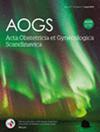Hospital obstetric volume and maternal outcomes: Does hospital size matter?
Abstract
Introduction
In recent decades, centralization of health care has resulted in a number of obstetric unit closures. While studies support better infant outcomes in larger facilities, few have investigated maternal outcomes. We investigated obstetric unit closures over time and whether obstetric volume is associated with onset of labor, postpartum hemorrhage (PPH) and obstetric anal sphincter injury (OASIS).
Material and Methods
All births registered in Sweden between 1992 and 2019 (Medical Birth Register, N = 2 931 140), linked with data on sociodemographic characteristics and maternal/infant diagnoses, were used to describe obstetric unit closures. After excluding congenital malformations, obstetric volume was categorized (low: 0–1999, medium: 2000–3999, high: ≥4000 births per year). Restricting to 2004 onwards (after most closures), the association between volume and onset of labor (spontaneous as reference) was estimated. Restricting to spontaneous, full-term (≥37 weeks gestation) cephalic births, we then investigated the association between volume and PPH and, after excluding planned cesarean sections, OASIS. Odds ratios from multilevel (logistic) models clustered by hospital were estimated.
Results
The 20 dissolved obstetric units (1992–2019) had relatively stable volume until their closure. Compared to the average, women birthing in the highest volume hospitals were older (31.3 years vs. 30.4) and a higher proportion had >12 years of education (57 vs. 51%). Compared to high-volume hospitals, there was no significant difference in labor starting by elective cesarean section or induction, rather than spontaneously, among low (OR 0.88, 95% CI: 0.73–1.06) and medium (OR 0.84, 95% CI 0.71–1.01) volume hospitals. There were lower odds of PPH among low (OR 0.72, 95% CI 0.63–0.85) and medium (OR 0.83, 95% CI 0.72–0.97) volume hospitals. No significant association was found between obstetric volume and OASIS (low: OR 0.98, 95% CI 0.82–1.18; medium: OR 0.90, 95% CI 0.77–1.05).
Conclusions
There was not a strong relationship between obstetric volume and maternal outcomes. Reduced odds of PPH for women birthing in smaller units may be due to triaging high-risk pregnancies to larger hospitals. While there was no significant association between obstetric volume and onset of labor or OASIS, other important factors related to closures, such as workload and overcrowding, should be investigated.


 求助内容:
求助内容: 应助结果提醒方式:
应助结果提醒方式:


